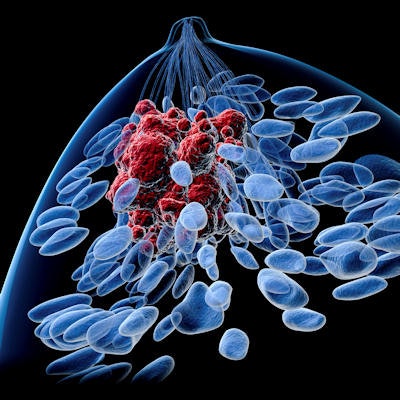
Contrast-enhanced breast MRI can triage patients with discordant benign breast biopsy results -- helping almost 70% of women in this situation to avoid unnecessary surgery, according to a new study published in the May issue of the American Journal of Roentgenology.
Avoiding unnecessary surgery truly benefits patients, wrote a team led by Dr. Linda Sanders of RWJ Barnabas Health in Livingston, NJ.
"Use of contrast-enhanced MRI could improve outcome by either showing absence of a clinically significant lesion (thereby avoiding surgical excision) or confirming the presence of an actionable lesion, leading to conclusive diagnosis of malignancy or borderline lesion," the group wrote.
Correlating pathologic results with imaging characteristics of the lesion sample is a key part of the biopsy process. If pathology and radiology don't match, then women often have to undergo additional invasive procedures such as excisional biopsy, according to the researchers (AJR, May 2019, Vol. 212:5, pp. 1157-1165).
"Concordant benign cases are those in which the biopsied lesions are deemed low suspicion (usually BI-RADS 3 or 4A)," the group wrote. "Follow-up imaging is the usual protocol, at either six or 12 months depending on the specifics of the case. However, if the benign pathologic results do not correspond well with the imaging (or clinical characteristics) of the biopsied lesion (discordant benign), excisional biopsy has been recommended as standard of care."
Sanders' group conducted a study to investigate whether contrast-enhanced MRI could shed light on discordant biopsy results and therefore help women avoid unnecessary surgery. The study included 45 patients with 46 lesions who underwent contrast-enhanced MRI after discordant ultrasound or stereotactic biopsy results between 2012 and 2018.
The researchers found that eight of 46 discordant lesions were malignant, for a rate of 17.3%, an "expected result" for BI-RADS 4 lesions, the group noted. Of the total discordant lesions, 28 were nonenhancing on MRI, and four patients had MRI findings that supported the original core biopsy diagnosis -- making surgery unnecessary for 31 of 45 (68.9%) patients.
| Performance of MRI in clarifying discordant biopsy findings | |
| Measure | Contrast-enhanced MRI |
| Sensitivity | 100% |
| Specificity | 93.3% |
| Positive predictive value | 85.7% |
| Negative predictive value | 100% |
| False-negative rate | 0% |
| False-positive rate | 6.7% |
The study shows that adding MRI to the diagnostic protocol on discordant biopsy results can reduce the rate of unnecessary further surgery, according to the group. But perhaps its utility could go even further.
"A more ambitious goal is to change the paradigm in breast intervention of BI-RADS 4 lesions by incorporating MRI into the management algorithm to reduce the frequency of benign biopsies," Sanders and colleagues concluded.



















